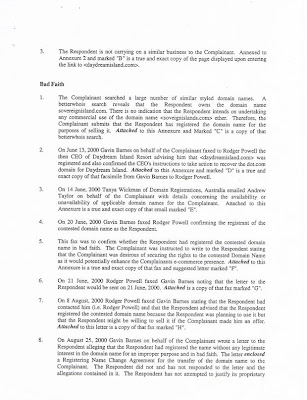DAYDREAM ISLAND RESORT
Whitsundays, Great Barrier Reef

ANNEXURE 2- 4C – GROUNDS ON WHICH THE COMPLAINT IS MADE
Copy or Similarity
1. The domain in dispute contains the word: “Daydream Island”. The Complainant owns 4 trademarks as shown in Annexure 1 all of which contain the trademarked word “daydream Island” as an image. In this regard, the Complainant submits that the domain name is identical or confusingly similar, and such a decision is reached whether the Respondent’s domain name is considered as “daydreamisland.com”, “Daydream Island” or “www.daydreamisland.com” .
2. Disregarding the prefects and the suffix in the contested domain name, the word Daydream Island as it appears in the domain name is exactly the same as the trademarks owned by the Complainant.
3. The Complainant is the current registrant of the domain name
1. It does not accurately reflect the name of the Complainant’s operating entity, namely Daydream Island Pty Ltd. Which operates and manages the day to day facilities and resort infrastructure and;
2. The Complainant’s business, is by its nature, commercial, and the
4. The Complainant submits that the trademarks are internationally renowned considering the proportion of international customers who have and will use the resort located on Daydream Island and whose initial point of contact has been through Daydream’s internet presence.
Illegitimacy
1. The Respondent has no rights or legitimate interests in the domain name as it has no proprietary rights in the registered trademarks or any other similar trademarks to the Complainant. The Respondent has not offered any evidence to the Complainant that he actually has or will use the name Daydream Island. Any assertion of future use is in the Complainant’s opinion, unsatisfactory as the Respondent has not conducted any advertising campaigns, market tests, focus groups, logo designs or any other related outlay with a bona fide offering of goods or services.
2. Based on information and belief, the Complainant submits that the Respondent has never had a viewable or live website, or even a page, at the contested domain name and that the Respondent has no products or services actually named Daydream Island.
3. The Respondent is not carrying on a similar business to the Complainant. Annexed to Annexure 2 and marked “B” is a true and exact copy of the page displayed upon entering the link to
Bad Faith
1. The Complainant searched a large number of similar styled domain names. A betterwhois search reveals that the Respondent owns the domain name sovereignisland.com. There is no indication that the Respondent has registered the domain name for the purposes of selling it. Attached to this Annexure and Marked “C” is a copy of that betterwhois search.
2. On June 13, 2000 Gavin Barnes on behalf of the Complainant faxed to Rodger Powell the then CEO of Daydream Island Resort advising him that
3. On 14 June, 2000 Tanya Wickman of Domain Registrations, Australia emailed Andrew Taylor on behalf of the Complainant with details concerning the availability or unavailability of applicable domain names for the Complainant. Attached to this Annexure is a true and exact copy of that email marked “E”.
4. On 20 June, 2000 Gavin Barnes faxed Rodger Powell confirming the registrant of the contested domain name as the Respondent.
5. This fax was to confirm whether the Respondent had registered the contested domain name in bad faith. The Complainant was instructed to write to the Respondent stating that the Complainant was desirous of securing the right to the contested Domain Name as it would potentially enhance the Complainants e-commerce presence. Attached to this Annexure is a true and exact copy of that fax and suggested letter marked “F”.
6. On 21 June, 2000 Rodger Powell faxed Gavin Barnes noting that the letter to the Respondent would be sent on 21 June, 2000. Attached is a copy of that fax marked “G”.
7. On 8 August, 2000 Rodger Powell faxed Gavin Barnes stating that the Respondent had contacted him (i.e. Rodger Powell) and the Respondent advised that the Respondent registered the contested domain name because the Respondent was planning to use it but that the Respondent might be willing to sell it if the Complainant made him an offer. Attached to this letter is a copy of that fax marked “H”.
8. On August 25, 2000 Gavin Barnes on behalf of the Complainant wrote a letter to the Respondent alleging that the Respondent had registered the name without any legitimate interest in the Domain Name Change Agreement for the transfer of the domain name to the Complainant. The Respondent did not and has not attempted to justify its proprietary interests in the contested domain name. Attached to this annexure is a copy of that letter marked “I”.
9. On or about 18 September, 2000, Doug Meagher, the current CEO of the Complainant, gave instructions to redchip lawyers to commence proceedings through the e-resolution domain name and administrative proceeding to recover the contested domain name.
10. Based on the above contentions, the Respondent has effectively prevented the Complainant from reflecting its trademarks in a corresponding domain name. The Complainant submits that in the absence of any associated business activity or other demonstrated purpose or intention, there circumstances support the inference that the continued maintenance of registration of the contested domain name after actual knowledge of the existence of the Complainant’s prior registered trademark (as shown in 3 above) is undertaken in bad faith.


























No comments:
Post a Comment